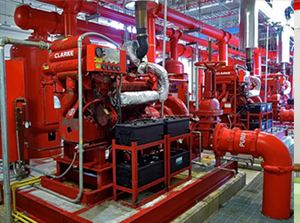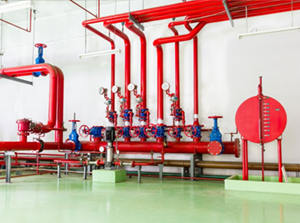Sprinkler Systems

Wet Systems
By a wide margin, wet pipe sprinkler systems are installed more often than all other types of fire sprinkler systems. They also are the most reliable because they are simple, with the only operating components being the automatic sprinklers and (commonly, but not always) the automatic alarm check valve. An automatic water supply provides water under pressure to the system piping.

Dry Pipe Systems
Dry pipe systems are installed in spaces in which the ambient temperature may be cold enough to freeze the water in a wet pipe system, rendering the system inoperable. Dry pipe systems are most often used in unheated buildings, parking garages, in outside canopies attached to heated buildings (in which a wet pipe system would be provided), or in refrigerated coolers. Dry pipe systems are the second most common sprinkler system type. In regions using NFPA regulations, dry pipe systems cannot be installed unless the range of ambient temperatures reaches below 40F/4.C
Deluge Systems
Deluge systems are systems in which all sprinklers connected to the water piping system are open, in that the heat sensing operating element is removed or specifically designed as such. These systems are used for special hazards where rapid fire spread is a concern as they provide a simultaneous application of water over the entire hazard. They are sometimes installed in personnel egress paths or building openings to slow travel of fire (e.g., openings in a fire-rated wall).
Pre-Action Systems
Pre-action sprinkler systems are specialized for use in locations where accidental activation is undesired, such as in museums with rare art works, manuscripts or books, and Data Centers for protection of computer equipment from accidental water discharge.
Pre-action systems are hybrids of wet, dry, and deluge systems, depending on the exact system goal. The two main sub-types of pre-action systems are single interlock and double interlock.
Water Spray
Water Spray systems are operationally identical to a deluge system but the piping and discharge nozzle spray patterns are designed to protect a uniquely configured hazard, usually being three dimensional components or equipment (i.e., as opposed to a deluge system, which is designed to cover the horizontal floor area of a room). The nozzles used may not be listed fire sprinklers, and are usually selected for a specific spray pattern to conform to the three dimensional nature of the hazard (e.g., typical spray patterns being oval, fan, full circle, narrow jet). Examples of hazards protected by water spray systems are electrical transformers containing oil for cooling or turbo-generator bearings. Water spray systems can also be used externally on the surfaces of tanks containing flammable liquids or gases (such as hydrogen). Here the water spray is intended to cool the tank and its contents to prevent tank rupture/explosion and fire spread.
